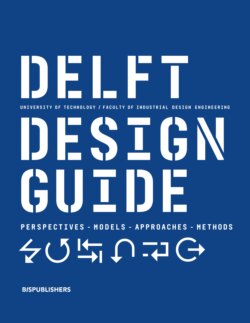Читать книгу Delft Design Guide -Revised edition - Annemiek van Boeijen - Страница 50
На сайте Литреса книга снята с продажи.
ОглавлениеAgile Design & Development
MODELS
49
How? Agile in itself doesn’t tell you what to do next: it is a set of values and principles, which is mostly about mindset, not about the process to follow. To be agile, designers should cherish the diversity in the team, be comfortable in not knowing what the exact outcome will be, be proactive to inspect and adapt their work and way of working, and naturally share energy, information, and results.
The Manifesto for Agile Software Development is based on 12 principles which can be applied to innovation processes in general:
---------------------------------
1. Provide customer satisfaction via early and continuous delivery.
---------------------------------
2. Welcome changing requirements, even late in development.
---------------------------------
3. Deliver working results frequently, for example, in weeks rather than months.
---------------------------------
4. Create close, daily cooperation between business people and developers.
5. Build projects around motivated individuals, who should be trusted.
---------------------------------
6. Practice face-to-face conversation, which is the best form of communication.
---------------------------------
7. Utilise working results, which is the primary measure of progress.
---------------------------------
8. Attain sustainable development to be able to maintain a constant pace.
---------------------------------
9. Continuously focus on technical excellence and good design.
---------------------------------
10. Recognise the necessity of simplicity, or the art of maximising the amount of work not done.
---------------------------------
11. Realise that the best constructions, requirements, and designs emerge from self-organising teams.
---------------------------------
12. Allow the team to regularly reflect on how to become more effective and to adjust accordingly.
What & Why? Innovation is often being slowed down due to delays and rework, particularly in the phase of delivery. Writing elaborate plans or project initiation documents often takes a lot of time, and once delivered, these plans and documents take away most flexibility to adapt to new insights, changes in context, and so on. People are often seen as interchangeable resources to be moved around, rather than part of teams that drive innovation. Clients are also viewed as legal entities rather than collaborators. Speed is essential in innovation, especially towards delivery. Agile comes into play at this stage; it helps to put well-performing teams in the driver’s seat of innovation and fast-track development while keeping maximum flexibility in what to deliver.
------------------------------------------------------------------------------------------------------------------------
Mindset: Agile is a mindset that is based on four values that are formulated in the Agile Manifesto. Value individuals and interactions over processes and tools; working results over comprehensive documentation; customer collaboration over contract negotiation, and responding to change over following a plan.
Tips & Concerns
A common means of making the progress visual is working with a Scrum board and Post It notes. All these could easily camouflage that the actual Agile mindset itself is absent, and these boards and notes only serve as innovation theatre.
---------------------------------
Limitations
The Agile mindset is a rather abstract set of values and principles. It takes effort and practice as well as an open mind to grasp and internalise it.
Agile is an approach to design and development. Its purpose is to accelerate the process and add flexibility. Agile values and principles originated in software development, and they are being applied to more and more disciplines, including design.
---------------------------------------------------------------------------------------------------------------------------------------------------------------
---------------------------------------------------------------------------------------------------------------------------------------------------------------
References & Further Reading Jongerius, P., Offermans, A., Vanhoucke, A., Sanwikarja, P., & van Geel, J., 2013. Get Agile!: Scrum for UX, Design & Development . BIS Publishers.
